What is PaaS? A beginner's guide to Platform as a Service
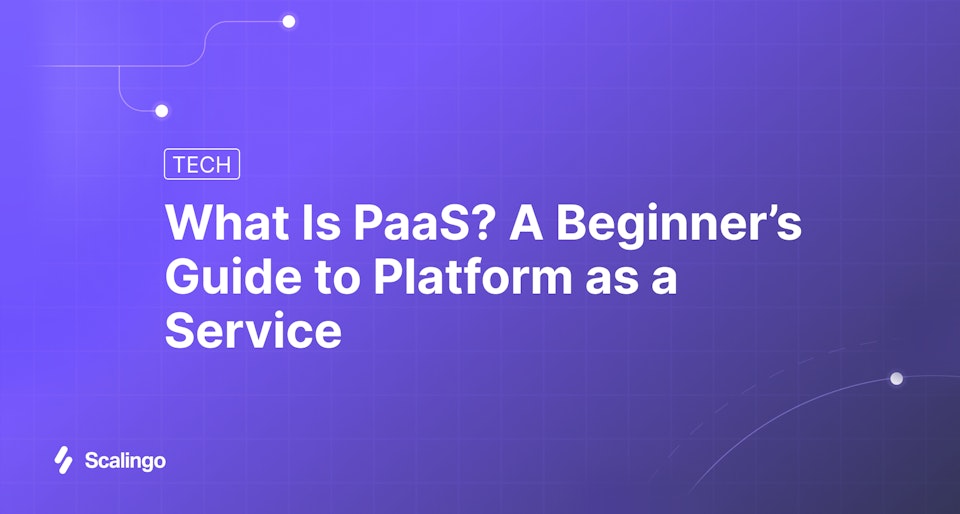
If you’ve spent any time on our site, you’ve definitely seen us mention the word PaaS - after all, Scalingo is a Platform as a Service. But what exactly is a PaaS? What does it do, and how is it different from things like IaaS or SaaS?
If you’ve been asking yourself those questions, you’re in the right place. In this guide, we’ll walk you through:
- What a PaaS is and what it’s used for
- How it compares to IaaS and SaaS
- The key benefits (and limitations) to help you figure out if it’s the right choice for your next project
Whether you’re a student, developer, CTO, architect, or just curious about cloud platforms, this article will give you a clear and comprehensive overview of everything you need to know.
Ready to dive into the world of PaaS? Let’s get started!
PaaS definition: What is a PaaS?
A PaaS, or Platform as a Service, is a cloud computing model that abstracts away the complexity of infrastructure management to streamline the development, deployment, and scaling of web applications.
With a PaaS, developers don’t need to provision servers, configure runtimes, or handle system maintenance. The platform manages all of that for you, automatically. This ZeroOps (or NoOps) approach shifts operational responsibility to the platform itself, enabling teams to focus entirely on writing code, delivering features, and accelerating release cycles.
The Full PaaS Experience
In this article, we're focusing on public PaaS, which is built on top of cloud infrastructure. That means:
- Your data is stored and backed up in the cloud
- You benefit from flexible, usage-based pricing (at Scalingo, we bill by the minute)
- You get access to a suite of integrated tools that streamline development and deployment
But a PaaS isn’t just cloud infrastructure like an IaaS, and it’s not simply a turnkey app like a SaaS either. It’s a full-fledged platform that brings together:
Core infrastructure components you’d find in an IaaS—compute, storage, networking—provisioned and managed automatically
An abstraction layer for running your code, including runtime support, automatic language detection, buildpacks, and an integrated build pipeline
Operational services for the full application lifecycle, such as automated deployments, monitoring, scaling, log management, and database provisioning
In short, a PaaS goes far beyond raw infrastructure or pre-built software. It provides a complete environment to host, deploy, and scale your applications—without the heavy lifting.
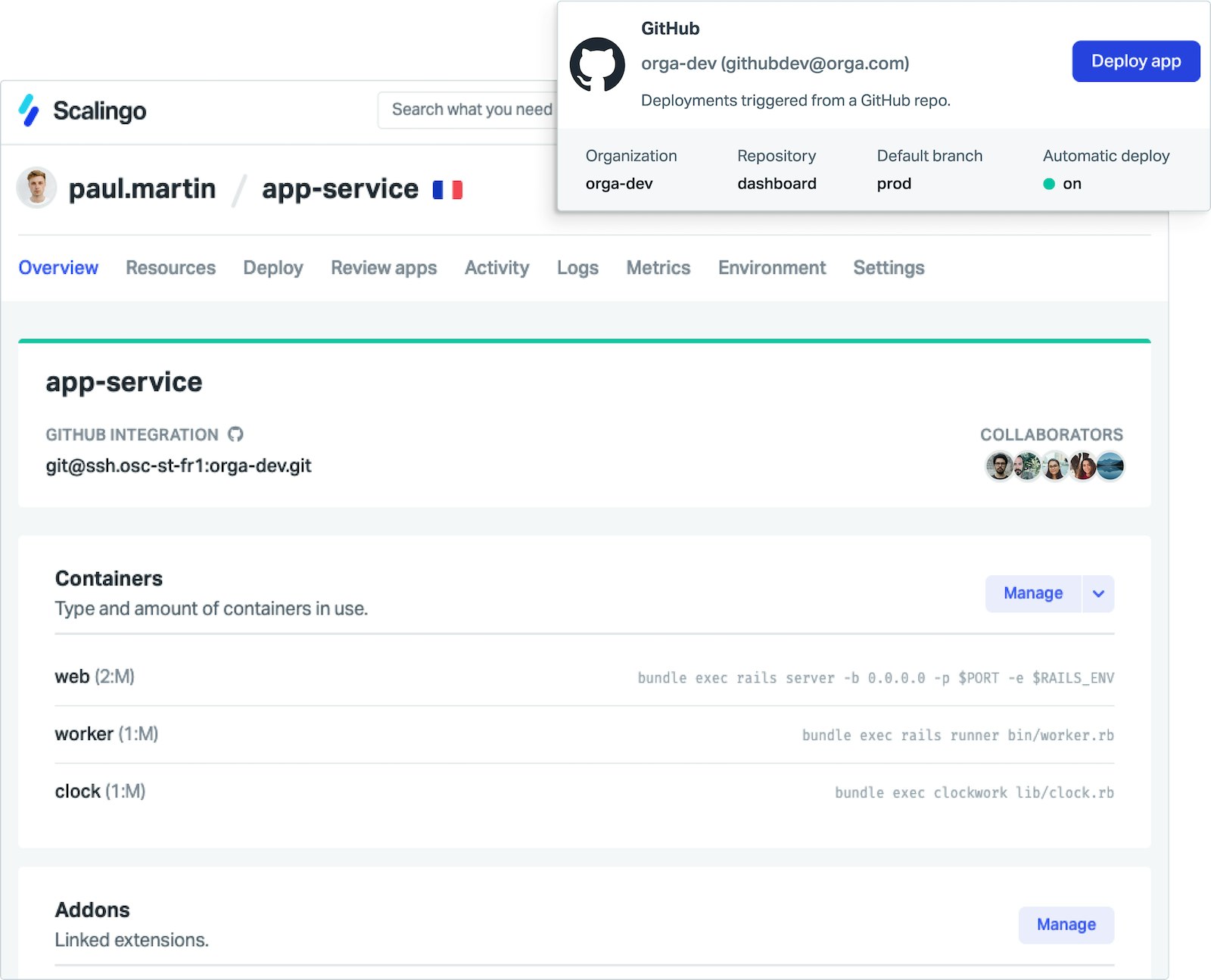
PaaS vs IaaS vs SaaS: What’s the Difference?
At first glance, the distinctions between the main cloud service models - IaaS, PaaS, SaaS, and even CaaS - can seem a bit blurry, especially if you’re not deeply technical. But in reality, each model serves a specific purpose. The right choice depends on how much control you need, the internal resources you have, and the nature of your project
IaaS – Infrastructure as a Service
IaaS provides the basic building blocks of cloud computing—virtualized servers, storage, and networking. It gives you raw infrastructure, usually hosted in the cloud, with full control over how it’s configured and used.
Everything above that layer—like the operating system, runtime environments, databases, and security—is your responsibility. It’s a highly flexible model, but it requires strong in-house expertise in system administration and DevOps to manage effectively.
PaaS – Platform as a Service
PaaS goes a step further by providing not just the infrastructure, but also the deployment and runtime environment for your applications. This model, often referred to as ZeroOps or NoOps, offloads routine operational tasks like server management, updates, and backups. Developers just need to push their code—the platform handles the rest.
It’s a powerful middle ground between flexibility and simplicity, allowing teams to move faster while reducing the operational burden.
Some PaaS platforms, including Scalingo, also offer DBaaS (Database as a Service) features. That means you can provision and manage databases in just a few clicks, without worrying about setup, availability, or maintenance. The result is a fully integrated environment designed to support developers throughout the entire application lifecycle.
SaaS – Software as a Service
SaaS is all about delivering fully functional software to end users. It’s a turnkey solution, typically accessible through a web browser, with no installation or infrastructure to manage. Some of the most well-known French SaaS companies include Aircall, Mirakl, PayFit, Sendinblue (Brevo), 360Learning, and Pennylane — each playing a major role in fields like cloud telephony, HR, e-commerce, EdTech, and financial management.
Everything is handled by the provider: updates, hosting, security, and maintenance. This model is perfect for end users who just need a tool that works, without having to think about any of the underlying tech.
CaaS – Container as a Service
CaaS is a cloud service model that allows developers to manage, run, and orchestrate containerized applications at scale. It sits one layer above IaaS, abstracting away the complexity of the underlying infrastructure while providing powerful tools for container lifecycle management.
CaaS platforms typically rely on orchestrators like Kubernetes, making it easier to deploy, scale, and monitor containers without having to manually manage servers. Compared to PaaS, CaaS offers greater flexibility and control over the runtime environment—but it also requires deeper technical expertise to handle container orchestration and infrastructure configuration.
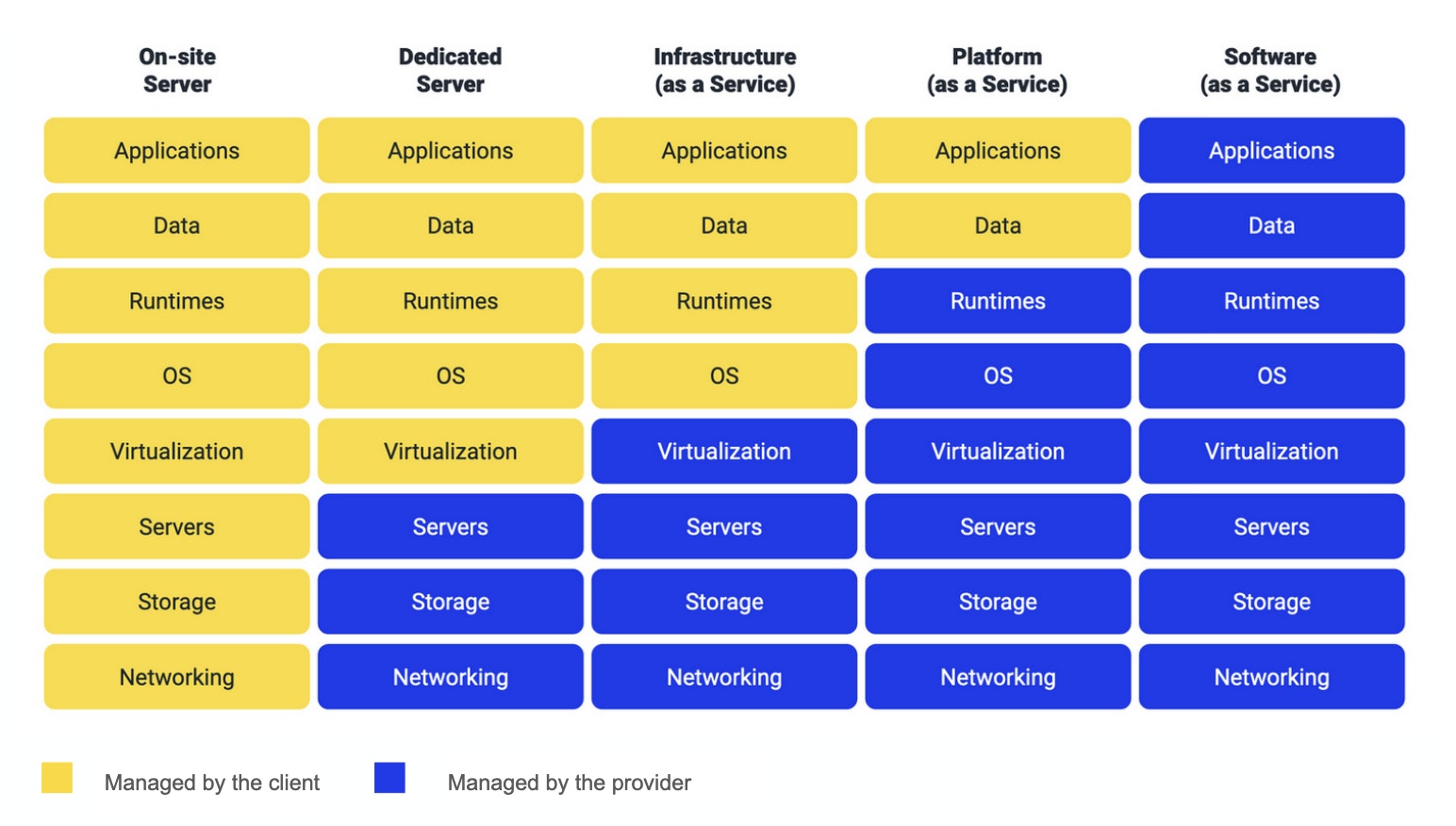
Core Components of a PaaS
A Platform as a Service (PaaS) is much more than just a place to host your applications. It provides a complete environment for development, deployment, and operations—designed to make developers’ lives easier while ensuring performance, reliability, and scalability.
Here’s what a PaaS like Scalingo typically offers:
Managed Cloud Infrastructure Servers, storage, networking—the entire underlying infrastructure is fully managed. Everything runs in a secure, redundant, and isolated environment, so you don’t have to worry about the low-level setup.
Streamlined Deployments Manage your applications directly from the platform using Git-based workflows, smooth CI integration, and automatic deployments triggered on every push. Shipping code becomes fast and frictionless.
Review Apps Every time you open a pull or merge request, Scalingo can spin up a temporary, isolated environment to test your changes before going live. These apps clone the main app’s config (stack, environment variables, add-ons)—but not the data—and are automatically destroyed when the PR is closed. It’s a safe, collaborative way to validate features without touching production.
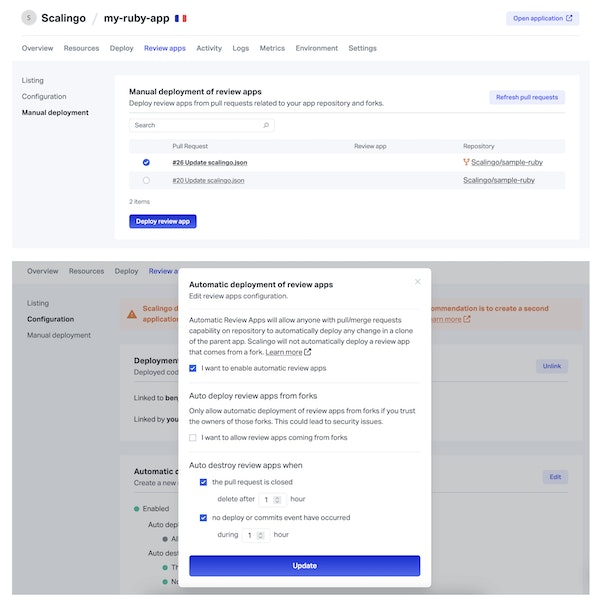
Managed Databases Out-of-the-box support for both SQL and NoSQL databases—PostgreSQL, Redis, MySQL, and more. Provision them in a click, with automated backups and easy restoration whenever needed.
Monitoring and Insights The Metrics dashboard gives you real-time access to key indicators like requests per minute (RPM), memory usage, and CPU load. Everything is visual and easy to monitor to help you stay on top of performance.
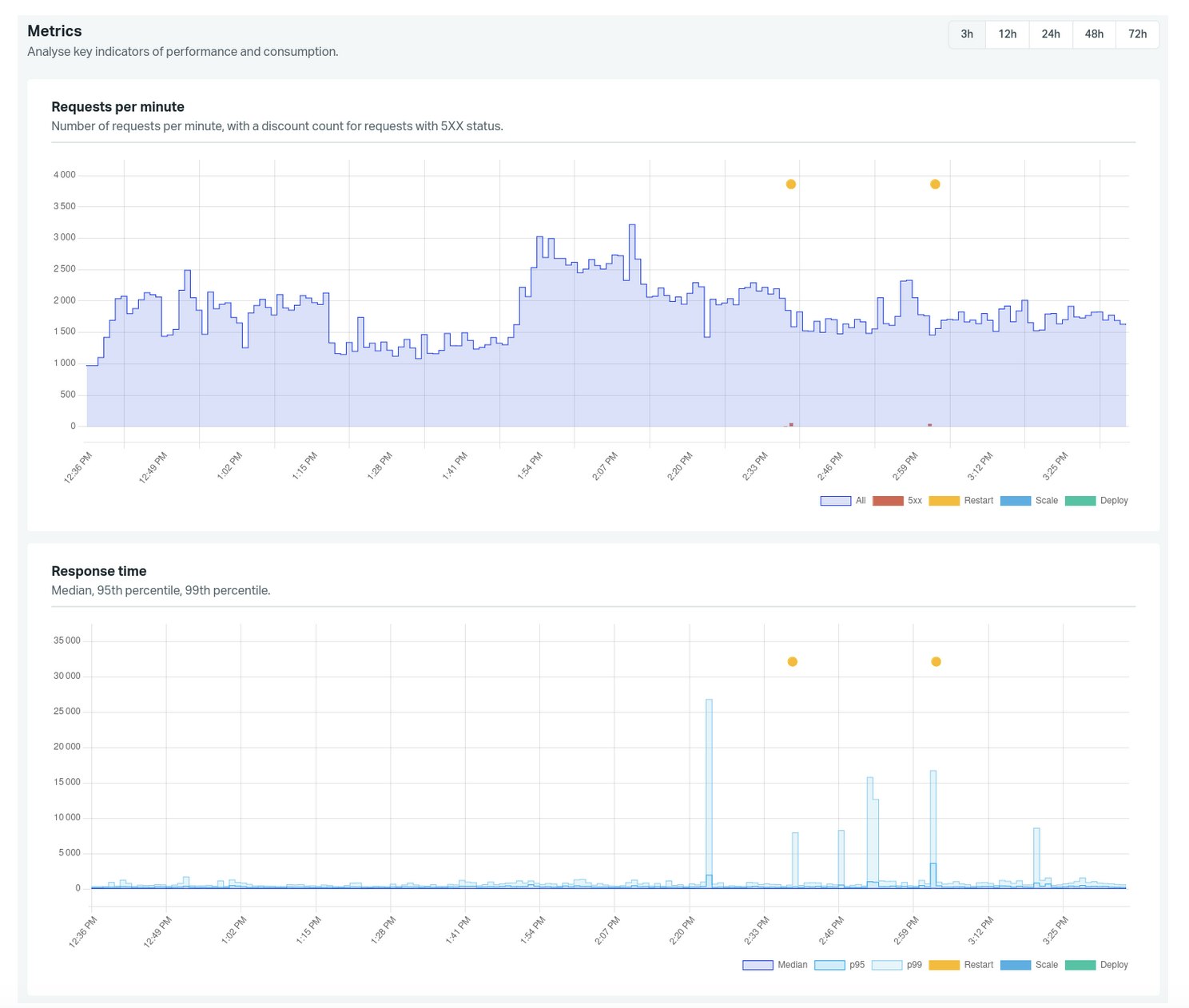
- Autoscaling Your applications can automatically scale based on traffic or custom metrics—keeping performance consistent even during high load or sudden spikes.
A Concrete Example
Picture this: a developer has a brilliant idea, spends the week building it out, and now wants to get their application online.
Without a PaaS, things get complicated fast. They’d need to spin up and configure a server, install the operating system, handle networking, set up the database, and package the app—whether as a container or something else. And that’s just the beginning. There’s also ongoing maintenance, security updates, monitoring... Every deployment becomes a technical maze filled with manual steps and potential pitfalls.
Now imagine the same developer using a PaaS. They can deploy their app in minutes, monitor performance in real time, manage databases with just a few clicks, and enable features like autoscaling—without ever touching a server.
In short, a PaaS strips away the infrastructure headaches, so developers can focus entirely on their code and product. The result? Faster, more reliable deployments with less friction—no matter the size or stage of your company.
So Why Isn’t Every Company Using a PaaS?
If Platform as a Service offers so many advantages, it’s fair to ask: why hasn’t every company made the switch?
The truth is, several factors can slow down or complicate PaaS adoption:
Regulatory or Industry-Specific Constraints
Some organizations—especially in highly regulated sectors like finance, healthcare, or defense—face strict requirements around data hosting, encryption, and geographic location. While many modern PaaS providers (like Scalingo) meet high compliance standards—such as ISO 27001, HDS, or France’s SecNumCloud baseline—some companies still choose to maintain full control over their infrastructure, at least temporarily. This helps ensure regulatory compliance and can also provide additional reassurance to clients and stakeholders.
Very High Customization Needs
Some highly specific projects require fine-grained system-level configurations, access to specialized hardware, or deep low-level performance optimizations. In these cases, the abstractions provided by a PaaS can feel limiting. Teams may prefer an IaaS or on-premise approach that gives them complete control over the technical environment and the freedom to tailor it exactly to their needs.
Budget Concerns… Often Misunderstood
Ironically, even though a PaaS often reduces overall costs—by cutting down on maintenance and lowering internal resource needs—it can sometimes appear more expensive than à la carte IaaS solutions.
This perception usually comes from a flawed comparison: looking at the raw price of a basic server versus the cost of an all-in-one platform. But once you factor in the time saved, built-in backups, native scalability, technical support, and reduced operational overhead, PaaS often proves to be the more cost-effective option in the long run.
Still, some IT departments or finance teams may fixate on the “sticker price” without considering the broader value.
A Strong In-House Tech Culture
Some engineering teams prefer to build and manage their entire infrastructure in-house—out of passion, conviction, habit, or simply because they have the skills to do so. These are often experienced teams capable of crafting a custom stack, tailored precisely to their needs.
In certain contexts, this approach makes perfect sense. It offers full control and deep visibility across every layer of the system.
But as the company grows—more projects, evolving teams, increasing scalability demands—this model can become heavy and difficult to sustain. That’s often when a PaaS becomes a serious alternative: less friction, more focus on the product.
Fear of Vendor Lock-In
One of the most common concerns around PaaS adoption is the fear of becoming too dependent on a single provider. And it’s not an unfounded fear—some major cloud players like AWS, Google Cloud, or Azure offer powerful but proprietary services that can be difficult to migrate away from once they’re tightly integrated into your applications. Custom APIs, platform-specific configurations, and proprietary databases can create a strong dependency on a single ecosystem. As a result, moving off those platforms can be complex, time-consuming, and expensive.
Fortunately, not all PaaS providers take this approach. At Scalingo, we’ve made openness and transparency a core part of our philosophy. We rely on standardized technologies—like buildpacks—that make it easy to move your applications elsewhere if needed. You also retain full ownership of your data, with simple tools to export it at any time.
Common Misconceptions About PaaS
PaaS is still surrounded by a few persistent misconceptions that can slow down adoption. Let’s take a moment to clear up some of the most common ones.
“PaaS is just for beginners”
While it’s true that PaaS simplifies infrastructure management, and is great for starting out, that doesn’t mean it’s only for junior developers. Quite the opposite - PaaS is designed to help experienced developers move faster by freeing them from repetitive operational tasks. That way, they can focus on what really matters: architecture, features, user experience, and delivering value.
“PaaS isn’t secure”
It's true that some less transparent PaaS providers may raise concerns—but a serious PaaS puts security at the core of its architecture.
At Scalingo, that means strict certifications (ISO 27001, HDS, SecNumCloud compliance), data centers located in France, automated backups, continuous monitoring (with MCO options), and a clear commitment to data sovereignty and privacy.
The result? A level of security that often exceeds what most companies could realistically implement on their own.
“PaaS is technically limited”
Modern PaaS is anything but limited. You get access to a wide range of languages, frameworks, databases, observability tools, fine-grained configuration options, autoscaling, CI/CD workflows, add-ons, and more.
At Scalingo, you can even create your own custom buildpacks to support highly specific use cases—giving you full flexibility without giving up the benefits of the platform.
What Types of Companies Can Benefit from PaaS?
PaaS is a great fit for a wide range of organizations. In fact, Scalingo is used by all kinds of teams—digital agencies, scale-ups, public institutions, government services, and tech teams within large enterprises.
What they all have in common is the need to move quickly and efficiently, without compromising on security, reliability, or peace of mind.
Startups & Scale-Ups: When Every Hour Counts
When launching a product, every sprint, every deployment matters. Teams are often small, resources are limited—but the goals are big. In that context, wasting time managing servers or maintaining infrastructure quickly becomes a drag on momentum.
A PaaS lets you hit the ground running without getting bogged down in ops. With simplified deployments, built-in scalability, and ready-to-use tools, your team can stay focused on building and shipping.
And despite the misconception that PaaS is only good for prototyping, it actually provides a robust architecture built to scale—so you can grow fast without having to re-architect everything down the line.
SMEs: Looking for Balance
Growing small and mid-sized businesses often find themselves straddling two worlds: the need for agility, and the need to build long-term technical stability. They have to move fast, but also lay a solid foundation.
A PaaS helps them stay focused on delivering value without getting lost in technical complexity. There’s no need for a dedicated infrastructure team or constant tech stack decisions for each new project—the platform handles the operational load, absorbs traffic spikes, and adapts to the pace of the business, whether it’s scaling up or settling in.
Public Sector: Balancing Efficiency and Compliance
In local governments, public institutions, and state agencies, the challenges are often well defined: small IT teams, high security requirements, and strict regulatory pressure.
A sovereign PaaS provides a secure, France-hosted environment that complies with key standards (ISO 27001, HDS, SecNumCloud), while remaining easy to use and operate. The result? Projects move faster without compromising on compliance—and teams gain real autonomy, without needing advanced DevOps expertise.
Web Agencies & IT Services: Delivering Faster & Standardizing Smarter
When you’re juggling multiple projects for different clients, every deployment can turn into a potential bottleneck. A PaaS helps bring consistency to your workflows—without sacrificing flexibility.
With automated deployments, multi-app management, on-demand add-ons, and built-in scalability, you save time without the overhead of custom infrastructure for every project. It’s a way to streamline and standardize delivery while keeping control over complexity—and your margins.
What About Large Enterprises?
In large organizations, infrastructure is usually well established—but agility often takes a hit due to complex processes, long validation cycles, and internal dependencies. A PaaS can empower project teams with greater autonomy. Whether it’s for a quick MVP, an internal tool, a test environment, or a project led by a subsidiary, a PaaS helps teams move faster—prototyping, testing, and deploying without waiting on infrastructure tickets.
And the best part? It all happens within the company’s existing security and compliance framework.
In Summary
Whether you’re a startup or a large enterprise, if your priority is agility, speed, and simplicity a PaaS could be the right solution for you.
How to Deploy an App on a PaaS Like Scalingo
So how does deploying an app on a PaaS like Scalingo actually work?
No complex setup, no servers to configure. In just a few minutes, your app is live and running.
It only takes 3 simple steps:
- Create your Scalingo account
- Connect your Git repository (GitHub, GitLab, etc.)
- Push your code
Scalingo takes care of the rest
Build, deployment, hosting, monitoring—it’s all automated. You can track your app’s performance in real time through a clean, powerful dashboard. No installs. No complex scripts. Just code, deploy, and go.
🎥 Want to see it in action? Check out our short demo video:
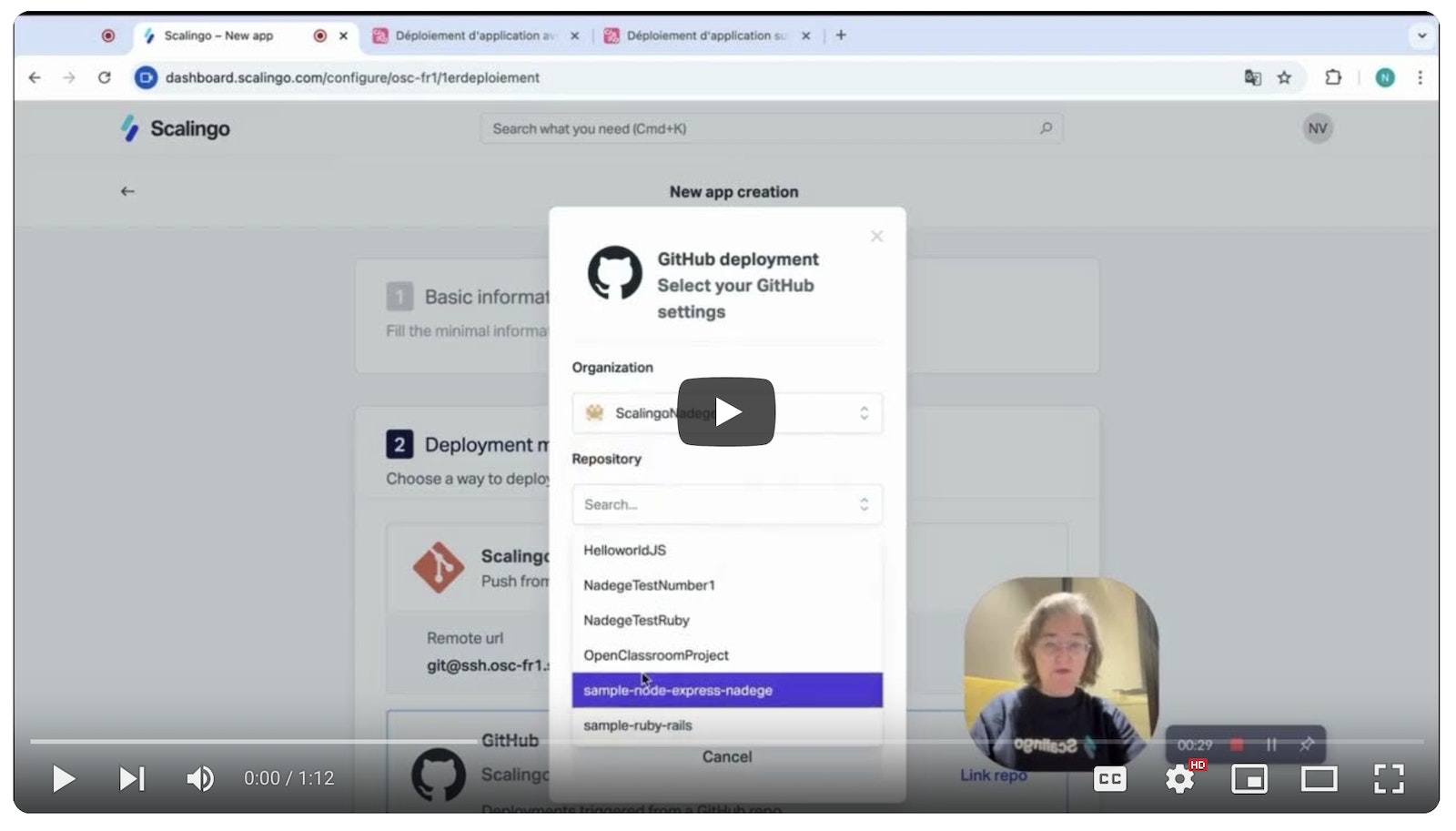
Our technical documentation is also there to guide you step by step. It's kept up to date by our own engineers, and designed to support you every step of the way.
Ready to Give It a Try?
Scalingo offers a 30-day free trial—no strings attached—so tech teams can deploy their first apps and experience a PaaS in real-world conditions.
It’s a great way to see the platform in action and decide for yourself.
And if you run into any questions or roadblocks along the way, our 100% human support team—made up of engineers, based in France—is here to help. Fast, technical, and always ready to listen.
See you soon on Scalingo.



